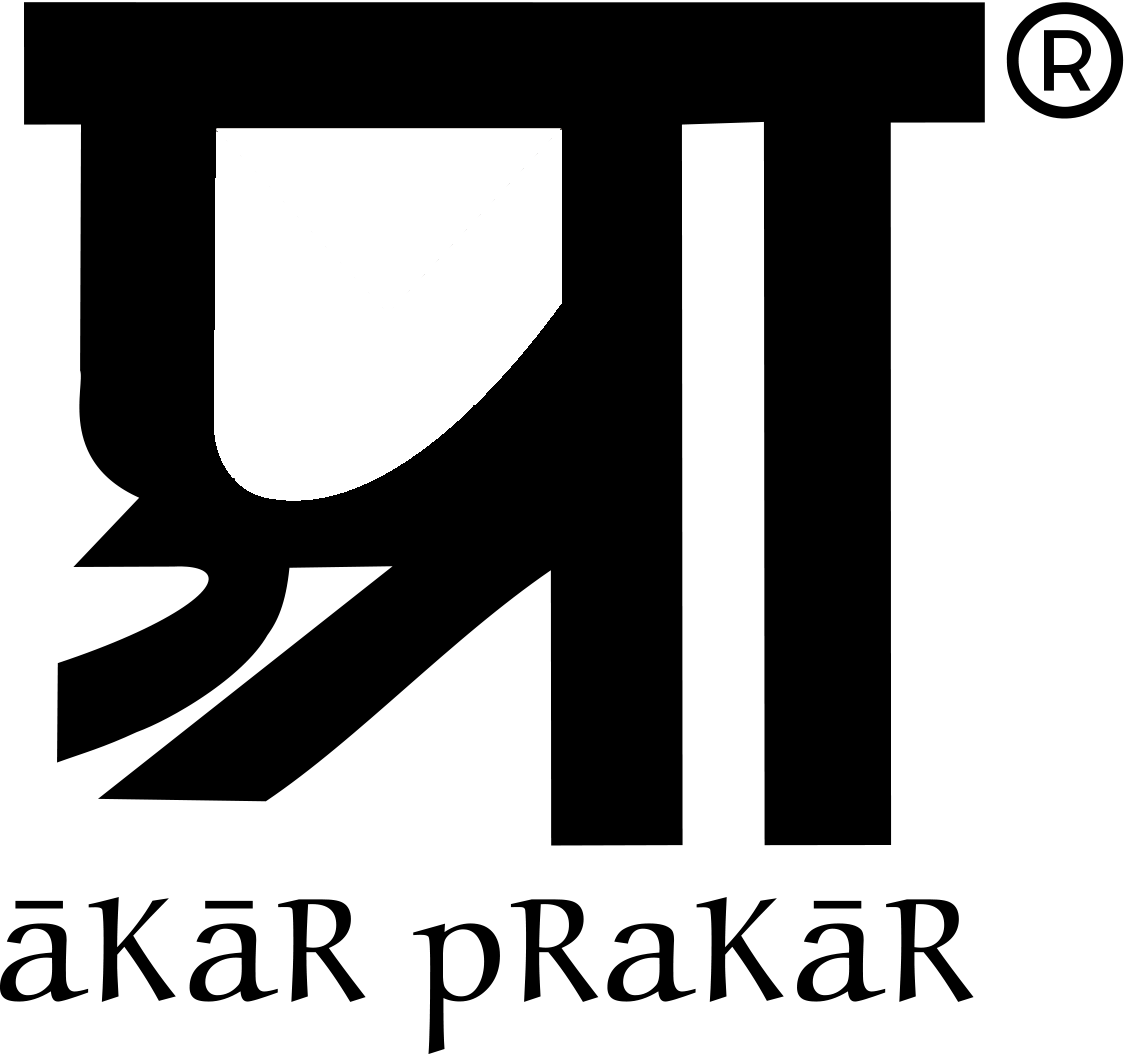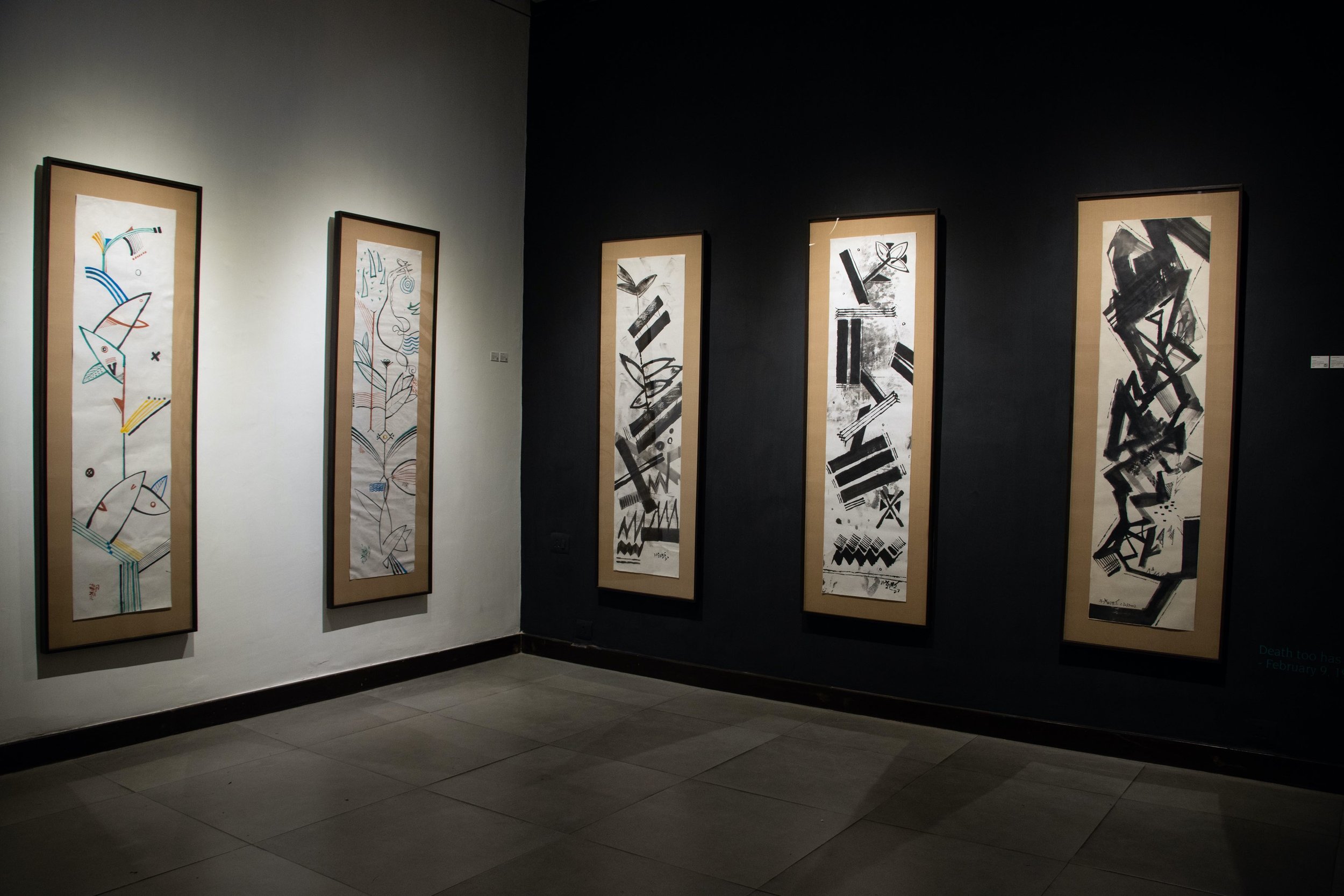
The Architectonics of Form: Scrolls by Ganesh Haloi
April 23, 2022 – July 16, 2022 at Akar Prakar, Kolkata
Sound is only the pulsation of the ups and downs of time and dimension.
- Ganesh Haloi.
Sound encompasses both time and space, weaving the two into complex structures of material manifestation that we experience and express as forms through our sensorial perceptions (smell, taste, see, feel and hear). The scrolls by Ganesh Haloi, are cartographic mappings of the layered sensations that have impressed upon him for decades. Beginning with the steady lyricism of Ajanta murals, resonant whispers of the varying landscapes, the rhythmicity of the alpana forms, structurality of manmade interventions and the poetics of space.
The architectonics of his visual forms are derived from and yet not limited by these layered impressions and the scrolls presented for the first time in this exhibition extend the survey into the dynamics of space as sound. The concept of sound is not limited to its physical attribution alone but is an expansive and uniting element that connects the human and universal realities. Defined as Urja-Chi-Prana-Shaoor-Consciousness-Dhvani, it exists as the invisible matrix conjoining dimensions.
There are two primary aspects that trigger the perceptive construction of the forms in Haloi’s scrolls. One is the aspect of space as perceived by the Chinese artist, enhancing the void with the minimalistic spontaneous brushstrokes that exemplifies the Daoist ideal of being in harmony with nature, devoid of the self. Dhvani, a theory of suggestions and revelations is the other binding element in Haloi’s composite forms and relations to space. Nandalal Bose’s sumi-e paintings are a fine example of both these elements, where he combines the spontaneity of the medium with the rhythmicity of forms to reflect his own idea of pranachhand, which is knowing that he and nature are governed by the same rhythm. The identity of the artist with the rhythmicity of nature is crucial in this amalgamation.
Haloi, on the other hand, neither loses himself to the empty space as the Chinese artist does nor forms a synchronized image in coherence with nature as Nandalal Bose does. Instead, he identifies himself with the space, pulsating in its form, pattern and multi-dimensionality. His identification is integral. To be integral means to be identified with all aspects of nature, through all the aspects of human sensing-knowing and pulsating with a hyper-intuitive knowledge system. The term “integral” is defined by Sri Aurobindo’s yoga system as “a seeking for a consciousness that is integral, an ontology of wholeness which overcomes the alienated discontinuity of human existence”.
Haloi’s architectonics derives from this process of integrality. To experience and express nature as a whole. Synchronizing its lyricism, rhythm, resonance, structurality and poetics into a coherent formula. This process abstracts the physicality of forms, and its psychological translucency of meanings and sensations into a sonic algorithm—enfolding, unfolding, and refolding the space-time flux into a continuous act of abstraction, until the self-image is integral to a visual formula of sonic symbolism. The void/space impregnated with dhvani, gives birth to this pulsating architectonic of form.
Curated by Jesal Thacker
Ganesh Haloi | Untitled 23 | Gouache and Chinese ink stick on Japanese scroll paper | 27.5 x 53.5 in | 2021
Ganesh Haloi | Scroll 22 | Gouache and Chinese ink stick on Japanese scroll paper | 53.5 x 13.75 in | 2021
Ganesh Haloi | Scroll 21 | Gouache and Chinese ink stick on Japanese scroll paper | 53.25 x 13.75 in | 2021
Ganesh Haloi | Scroll 20 | Gouache and Chinese ink stick on Japanese scroll paper | 53.25 x 13.75 in | 2021
Ganesh Haloi | Scroll 19 | Gouache and Chinese ink stick on Japanese scroll paper | 53.25 x 13.75 in | 2021
Ganesh Haloi | Scroll 18 | Gouache and Chinese ink stick on Japanese scroll paper | 53.5 x 13.75 in | 2021
Ganesh Haloi | Scroll 17 | Gouache and Chinese ink stick on Japanese scroll paper | 53.5 x 13.75 in | 2021
Ganesh Haloi | Scroll 16 | Gouache and Chinese ink stick on Japanese scroll paper | 53.5 x 13.75 in | 2021
Ganesh Haloi | Scroll 15 | Gouache and Chinese ink stick on Japanese scroll paper | 53.5 x 13.75 in | 2021
Ganesh Haloi | Scroll 14 | Watercolour on Japanese scroll paper | 53.5 x 13.75 in | 2021
Ganesh Haloi | Scroll 13 | Gouache and Chinese ink stick on Japanese scroll paper | 53.5 x 13.75 in | 2021
Ganesh Haloi | Scroll 12 | Chinese ink stick on Japanese scroll paper | 53 x 13.75 in | 2021
Ganesh Haloi | Scroll 11 | Chinese ink stick on Japanese scroll paper | 50.25 x 13.75 in | 2021
Ganesh Haloi | Scroll 10 | Chinese ink stick on Japanese scroll paper | 54.25 x 13.75 in | 2021
Ganesh Haloi | Scroll 9 | Chinese ink stick on Japanese scroll paper | 54.25 x 13.75 in | 2021
Ganesh Haloi | Scroll 8 | Chinese ink stick on Japanese scroll paper | 53.75 x 13.75 in | 2021
Ganesh Haloi | Scroll 7 | Chinese ink stick on Japanese scroll paper | 53.75 x 13.75 in | 2021
Ganesh Haloi | Scroll 6 | Chinese ink stick on Japanese scroll paper | 53.75 x 13.75 in | 2021
Ganesh Haloi | Scroll 5 | Chinese ink stick on Japanese scroll paper | 54 x 13.75 in | 2021
Ganesh Haloi | Scroll 4 | Chinese ink stick on Japanese scroll paper | 53.75 x 13.75 in | 2021
Ganesh Haloi | Scroll 3 | Chinese ink stick on Japanese scroll paper | 53.75 x 13.75 in | 2002
Ganesh Haloi | Scroll 2 | Chinese ink stick on Japanese scroll paper | 53.75 x 13.75 in | 2021
Ganesh Haloi | Scroll 1 | Chinese ink stick on Japanese scroll paper | 53.75 x 13.75 in | 2021
Ganesh Haloi
Ganesh Haloi (b.1936) was born in Jamalpur, Mymensingh(in present-day Bangladesh). He moved to Calcutta in 1950 following the partition. The trauma of displacement left its mark on his work as it did on some other painters of his generation. Since then his art has exhibited an innate lyricism coupled with a sense of nostalgia for a lost world. In 1956, he graduated from the Government College of Art and Craft, Calcutta. In the next year he was appointed by the Archaeological Survey of India to make copies of Ajanta murals. Seven years later, Haloi returned to Calcutta. From 1963 until his retirement, he taught at the Government College of Art and Craft. He is a member of The Society of Contemporary Artists, Calcutta since 1971, and lives and works in Calcutta.
He has participated in several group exhibitions in India, Greece/Germany (Documenta 14 at Athens & Kassel), California (Architecture of Life, at Berkeley Art Museum & Pacific Film Archives (BAM/PFA), Berkeley), Berlin (8th Berlin Biennale for Contemporary Art), London (A Special Arrow Was Shot in the Neck, David Roberts Art Foundation). He is represented by Akar Prakar Kolkata and New Delhi, and has had various solo exhibitions in Kolkata, Delhi, Mumbai, Dhaka and New York including Sense & Sensation at Akar Prakar Kolkata and New Delhi in 2021, Form & Play at Asia Week New York in 2020 to name a few.





























